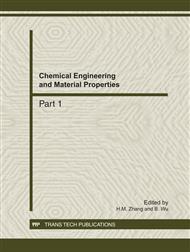p.230
p.236
p.242
p.246
p.250
p.255
p.260
p.264
p.269
Effective Reinforcement of Graphene in Poly (vinyl alcohol) Nanocomposites at Low Loading via Enhanced Interfacial Interaction
Abstract:
The graphene/poly(vinyl alcohol) nancomposites with enhanced filler-matrix interfacial interaction were fabricated via water-blending partially reduced graphene oxide (PRGO) and poly(vinyl alcohol)(PVA). The nanocomposites were characterized by X-ray Diffraction(XRD), Fourier transform infrared spectroscopy(FTIR), Scanning Electron Microscopy(SEM), thermogravimetry(TG). The results showed that the graphene nanosheets were homogeniously dispersed in the PVA matrix and enhanced interfacial adhesion was greatly enhanced due to new covalent linkage and hydrogen-bonding between graphene and PVA backbone. The mechanical and thermal properties of the nanocomposites were significantly improved at low graphene loadings. An 116% increase in tensile strength and a 19°C improvement of onset thermal degradation temperature were achieved by the addition of only 0.8 wt% graphene.
Info:
Periodical:
Pages:
250-254
Citation:
Online since:
December 2011
Authors:
Keywords:
Price:
Сopyright:
© 2012 Trans Tech Publications Ltd. All Rights Reserved
Share:
Citation:



